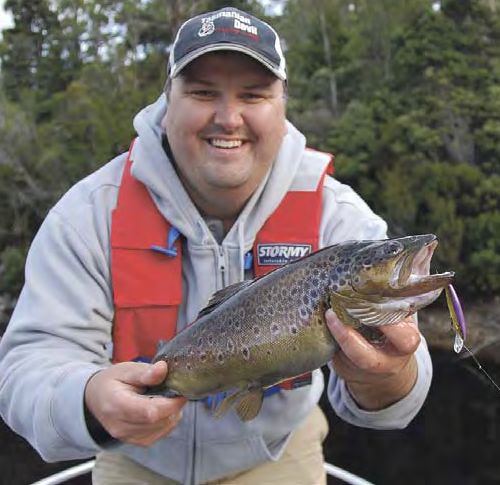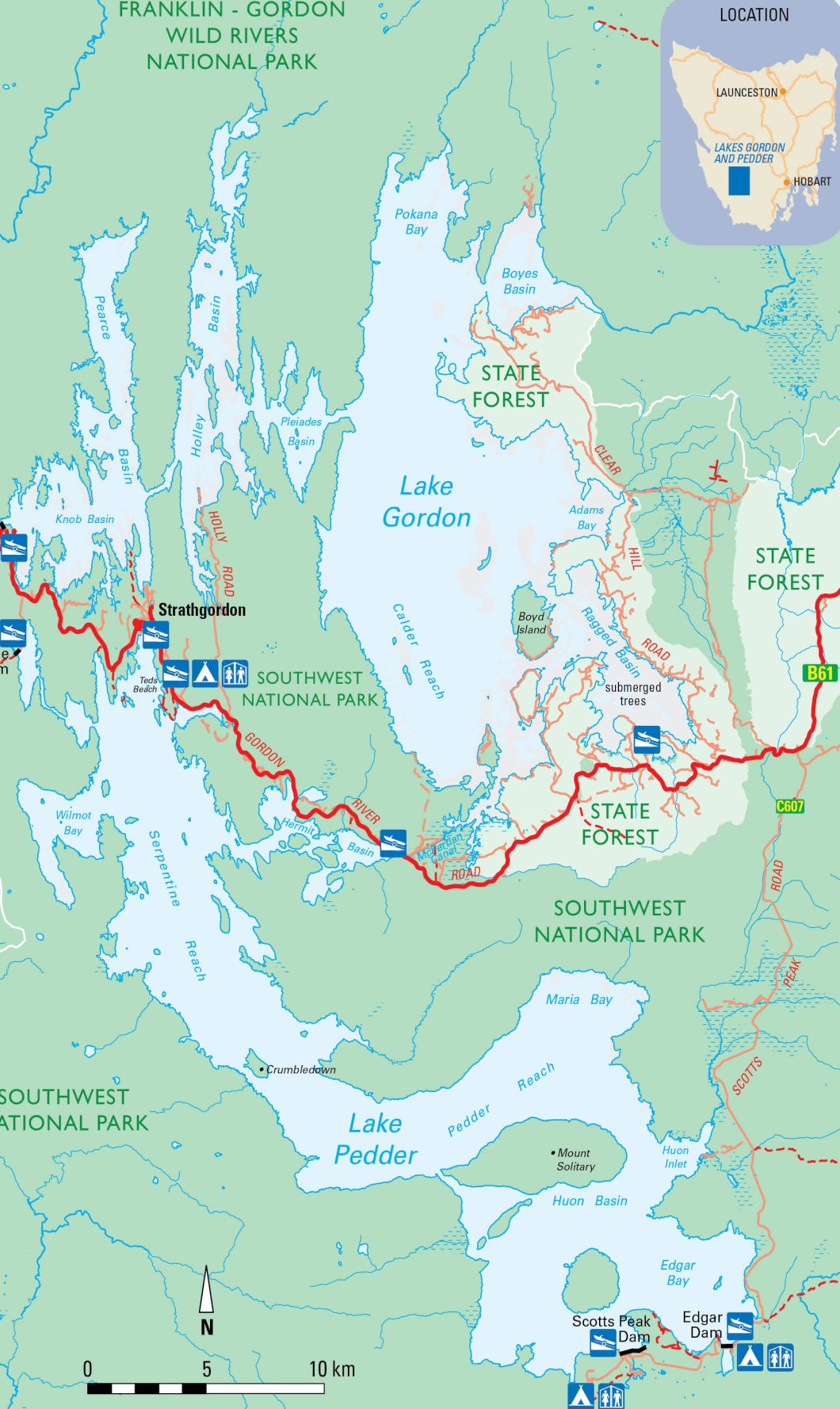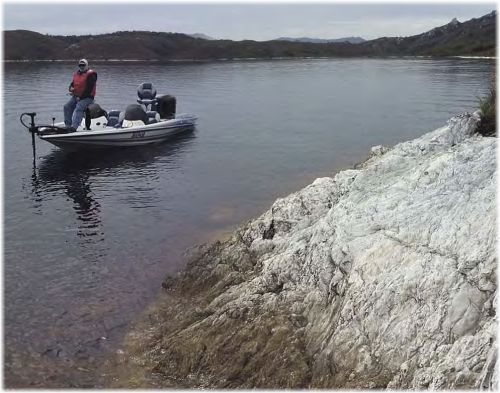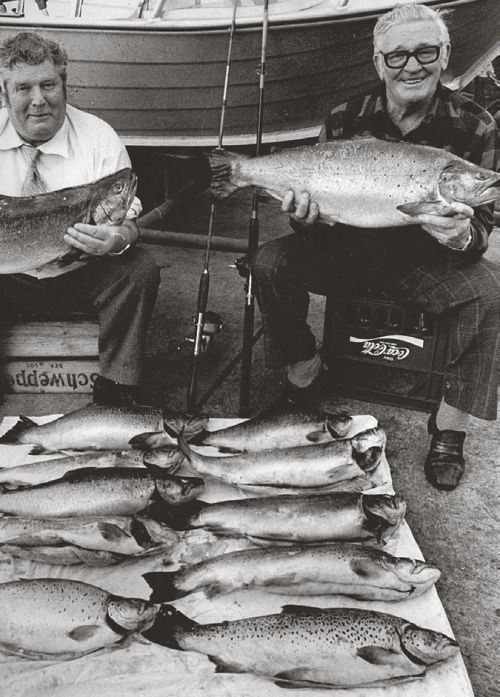 Presented from Issue 107, December 2013
Presented from Issue 107, December 2013
Lake Pedder whilst it has gained some popularity over the last few years it is still not high on the visitation list when compared to some of our other large water storages. It shouldn’t be the case as it has so much to offer and to the lure angler the options are almost endless. Lake Pedder is an immense water storage, controversially created in the late 70’s by the construction of 3 relatively small dams to hold and supply water to nearby Lake Gordon, itself an enormous water catchment that dwarfs Pedder in volume.
Pedder’s massive 242 square kilometre surface area creates the angling experience to cater for all lure methods. It’s great hitting the water with someone new seeing the place for the first time. While in awe of the scenery and imposing mountain ranges to the south first time visitors are equally struck by the continuing possibilities each time you round a point that opens up into a perfect looking bay, often followed by another and another.
 |
| Click on this map for a larger view in a new tab |
The trolling angler is the workhorse of the fishery. Always reliable and bound to find a few fish pretty much anywhere on the lake. Your thoroughbred stayer is the drift spinning angler, working every inch of chosen areas and almost certain to bring home the bigger bags when it matters.
There are five ramps available to boaters in Lake Pedder, in the north at Strathgordon, Serpentine and Hermit Basin (McPartlans) and in the south at Edgar Dam and Scotts Peak Dam. The southern ramps lie at the end of Scotts Peak Rd, some 20 or so kilometres of dusty, often bumpy white quartz gravel roadway. A drive that is these days far less popular than it was in the glory days of trout averaging 4kg. The Strathgordon, Serpentine and Hermit Basin ramps are all very accessible with the later exposed to the prevailing westerly weather while the other two are generally always extremely sheltered from 99% of the normal weather conditions.
There are two other less formal ramps, one widely used at Teds Beach just south of the Strathgordon township and Tea Tree Cove situated between the Edgar and Scotts Peak Dams in the south. Teds Beach offers shelter, BBQs and toilets while launching is directly off the quartz beach with a handy but small camping area nearby. Tea Tree Cove in the south is again a gravel ramp but seldom used. However the fishing here is one of my favourite shore based locations with some great little bays within a few minutes’ walk.
Trolling
Lake Pedder is a year round fishery in every sense of the word. Open for 12 months of the year it can produce good returns right through the calendar. While calm winter days are absolute gems out here with snow-capped mountains reflecting an already imposing view as far as the eye can see it is not generally until October that visitors start to hit the water chasing the wild brown trout.
All the staple lures do produce the goods out here. Tassie Devils in pinks or green and golds are long time and proven favourites. Bibbed lures with the Rapala spotted dog pattern extremely effective also. Shallow to mid running is the way to go. Lead line trolling is not overly successful in Pedder and that may be to do with the local food sources for the trout. Generally they are always looking up. An exception to this would be the local yabby population. These little critters are high on the menu for the trout with just about every second fish having a ‘claw’ in its stomach contents.
Shores to look for if chasing yabby feeders, which are often bigger and in better condition than other trout and almost certainly have bright red flesh, are the banks showing black mud. The yabbys burrow here as they have no chance on the hard quartz rock that often dominates the shorelines. Fishing deeper here although risking snagging up an expensive lure could find you a good fish. Fish a dark colour with a couple of bright highlights. Some of the best trolling circuits are very accessible and often adjacent to boat ramps. Out of Strathgordon the shorelines south on both the left and right of the ramp are quite good. Most head right where I would favour the left. Continue on to Teds Beach and the small partly submerged islands here in front of the bay are good options. The shoreline down to Trappes Inlet continues to produce fish. The back half of Trappes is also very popular, I find the front half is very deep and not as rewarding.
 |
| Working along the shores casting or trolling can bring good bags of fish |
Hermit Basin or more commonly called McPartlans by regular devotees is one of the best regions on the lake for the trolling angler. The shoreline to the north of the ramp is fantastic and trolling this bank in around 3m of water will consistently produce fish all day long. The entire Hermit Basin region offers countless bays and deep shores that as mention are very productive. Directly across the lake from where Hermit Basin opens to the main lake you will find Wilmot Bay. Once the home of some of the lake’s biggest fish it still now holds some very good trout and is probably the most popular part of the lake to fish. The northern shoreline runs almost east-west and it is the most productive circuit. Boats can continue from the NW corner of the bay south to drowned tree line spur which turns back toward the lake proper. This circuit again follows some very fishy water. Some boats turn here into Starfish Bay. It is not as deep as the Wilmot itself and is scattered with both dense and sparse flooded trees. A very productive region but also claims a bit of tackle each trip. Heading south down the lake Coronation Bay and the Crumbledown shores are both excellent areas although a reasonable boat would be recommended as the weather can be extremely changeable in this part of the world. The lures mentioned previously all once again very popular.
South of here, the lake is largely unfished these days except for some popular and consistent bays accessed from the two main southern ramps. North of Edgar dam the shore is very good. Trolling circuits around Mount Solitary was and is very popular. Outside the heavily tree lined Huon Inlet is a great spot if weather permits and can be exceptional nearing winter and spawning time. The shallower water around the Barrier Islands are also very productive and well worth the drive if in the south of the lake.
 |
| A blast from the past. A typical bag of fish from the 1970's |
Drift Spinning
This in my opinion is the best way to tackle Lake Pedder. An open boat can be more exposed to the elements on a big water like Pedder but spinning to the shores and trees on Pedder will bring home much bigger bags of fish.
Much like the trolling anglers, Hermit Basin is high on the list. The countless bays and points and very promising shorelines produce good numbers of fish. The Pedder fish seem to like a little bit of action in your retrieve, whether it be the odd pause or flick of the rod tip but it seems to lift your catch rate here. Colours to go for are again green and gold, black and gold and the ever reliable spotted dog. Purple also a very good option at Pedder. Small bibbed lures are ideal for the shallower shores but be warned with so much flooded tea tree and banksia around you will lose gear. Tassie Devils are perfect options on the average to deeper banks and while not widely used out here soft plastic do bring home the fish. I have had success on the trusty black and gold T-Tails and pumpkinseed minnows.
Wilmot Bay is again a great spot for drift spinning. The northern shore will give up large numbers of fish. The myriad of islands in Wilmot and just outside the bay itself are all worth prospecting. That’s the beauty of drift spinning, you can cover the water thoroughly and if there isn’t anything about just move on. Don’t waste hours on a shore with no fish. There are at least half a dozen islands in view from the Lake Pedder Chalet. All these are genuine fish catching locations as is the shoreline to the left of the ramp heading south. Overlooked by almost all it gives up many trout to my boat regularly.
In the south Huon Inlet is a gem. It is secluded but can be one of the lakes true hotspots. Be prepared to give up a few lures to the tackle gods here but reward is generally very good. The shoreline inside Little Barrier Island holds lots of fish and no surprise as it’s one of the biggest weed beds in the whole lake. Fish rise here as far as the eye can see on calm warm days.
The middle section of the lake again is largely untouched today. It does hold some magic bays, coves, beaches, trees and pristine water you’ll find anywhere on the lake. Fish here and you will not see another boat. The fishing is great but again a good reliable boat of reasonable size is recommended. It’s a long way from any of the ramps and it can change very quickly.
Coronation Bay on the western shore is the last well know region to mention. There is a mix of deep shores and shallow flats with a scattering of islands around. You can pick your favourite style of lure here and target the area you wish.
 |
| Justin Causby with a good size Pedder fish caught casting towards the shore |
Trolling Tips
Speed
I like to troll slow, slower than others would around 3.5 – 4 kph being the max speed where 4.5kph would be about average. I like to sit close to the rod so you can add extra action to a lure. Do this by holding the line and drawing it in then releasing quickly, this will make your lure dart and flutter. It often entices many strikes and is very effective on bibbed lures. It can be deadly with the action it can give to a Tassie Devil, despite it’s already aggressive action.
Line
The fish are many in Pedder but they are not that big, with an average size of around 500- 600gr. I use for spinning a 3lb fluorocarbon. Line of this size allows for much longer casting and the longer your lure is in the water the more chance you stand of catching fish. I’d certainly go no large than 6lb (2.7kg) line. You’ll be hard pressed to snap this on fish or snags before losing a lure.
I like fluorocarbon as it sinks as opposed to monofilament and allows your lures to swim at their true depth. When casting it allows your lure to get down to ‘the zone’ quicker than you would dragging mono under the surface as the lure descends.
Depth
Focus on water around the 3-5m mark. Many shores are far deeper and will hold fish, but the best fishing is around the shallower shores - often dotted with tea tree and the inevitable snags. A lure retriever is a must if you want good bags of fish.
Fishfinders
Remember spots you pick up fish or enter a waypoint on your sounder. Fish in Pedder do tend to hold or school on similar spots on return trips. I have many favourite places that are always reliable. I like the muddy looking banks as opposed to the barren rock shores. So much of the Pedder trout diet lives in or around the black clay shores or drowned trees; mudeyes, damsel and dragon flies and the yabby.
Top Three Lures
One would think if you had to choose three lures to make a successful trip to Lake Pedder it would be a tough decision given the myriad of lure choices these days. I think you could do it quite comfortably. Soft plastics would miss out and it’s all hard body lures for me;
- A Tassie Devil is the mainstay of trolling and colours; #51 Christmas Tree or #55 Pink Panther. The green, gold and red #51 is a proven fish taker and the hot pink #55 has always been a winner on Pedder, often under a less courteous name.
- Next – a bibbed hard body, colour black, gold and orange. Pick your brand they all work; Diawa Presso F6, Ecogear MW62, Cranka Minnows etc. It’s a deadly colour combo and trout can’t resist it. The #102 Tassie Devil is this very colour also.
- Equally as good would be the Tassie favourite Spotted Dog Rapala re-released last year and it’s still a gun colour. I’d probably go for the F7 size as opposed to the Count Downs. Yep Tassie Tackle make very good variations. The contrasting spots on this lure really get the fish excited and it is and has been a very successful colour over the years. This along with the #2 selection are equally good trolling as they are for spinning from the boat or shore.
Tips and tricks
The humble and often long forgotten fly dropper is an addition to your rig worth running at Pedder. The old Pedder Parrot was always a good offering. Any matuka style fly with a flash of colour worth a look but I would run a black fur fly with an olive body. Read the Ned Terry book on the glory days of Pedder, this is the fly that caught all the big fish. It resembles the mudeye and strangely enough black lures are well worth a try if things appear slow. To our eye you can barely seem them in the dark tannin stained water but the fish obviously do. Often over looked, the best silhouette to a fish looking up is made by the darkest lure.
Pedder is a massive expanse of water. Don’t be scared to explore it. Some of our best sessions have come from shores we have never fished before and essentially may not have seen a boat or angler for 20 years. My boat has landed limit bags on day one of the Back to Pedder events for the last couple of years and it’s not by doing anything special. Cast hard to the shores, be prepared to snag up, lots.
Look for rising fish
Early mornings the lake is covered by fish midging in the wind lanes across the open expanses of the lake. Provided the lake is not littered with millions of these tiny bugs you can land these fish on lures. We have found the best way to do this is using a small hard body lure, an Ecogear MX48 is ideal, watch the fish move and work out which way its headed. Cast out well ahead of the fish and past its course. Retrieve to you are just shy of its path, as it’s close draw your lure forward either slowly or twitching it along. Then it’s up to the fish. It will either eat it or it wont. As I said you ‘can’ land these fish on lures. When they are not eating lures and concentrating solely on midges it’s the most frustrating fishing you will experience. Just don’t cast too close to them as they spook easily and will disappear in an instance.
Facts
Lake Pedder is open year round. There is a 220mm legal size and 20 fish bag limit in place. A National Parks Pass is required to access some parts of Lake Pedder. The Lake Pedder Chalet is currently open 12 months of the year. It offers comfortable affordable accommodation. Meals are available to purchase and very warm and hearty after a cold day on the water.
See this link for current information.
Justin Causby. Manager – Wigston’s Lures
